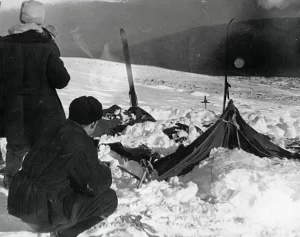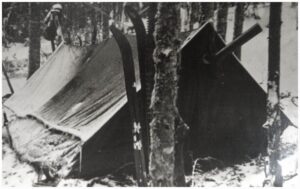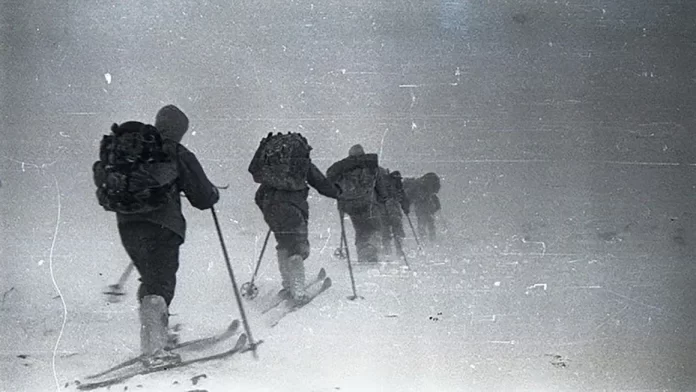Introduction
In the early winter months of 1959, nine hikers decided to embark on a skiing expedition in the northern Ural mountains of the Soviet Union. Every hiker in the group was experienced and familiar with the harsh Siberian weather of the Ural mountains. However, despite this, the trip would end in disaster for all of the hikers as they would all die in brutal and mysterious circumstances. Despite countless hours of research, on-site investigations, and more, the case remains unsolved nearly 65 years later and continues to baffle investigators and researchers alike.
Initial trip
In the early morning of January 23rd, 1959, a ski hiking team of ten boarded a train bound for the Ural mountains. The group consisted of eight men and two women, one of the men, Igor Dyatlov, whom the case is named for, served as the leader of the group.

After the train, the group boarded various other methods of transportation until finally arriving at the foot of the mountain range and then proceeding on foot and skis. On January 28th one of the original 10 hikers, Yuri Yurdin, began to feel unwell and eventually decided to head back and not continue with the trip. He would be the only survivor. On February 1st the remaining group members reached the foot of a place known as “Death Mountain” to the indigenous Mansi people of the area; they spent most of the day progressing up the mountain and ultimately set up camp a few hundred meters from the peak. Once they set up camp one of the camp members entered what would be the last diary entry from the group, the entry reading
“It is difficult to imagine such a comfort on the ridge with shrill howling wind, hundreds of kilometers away from human settlements”
This chilling entry foreshadowed the disaster the group would soon face.
The disappearance
As the weeks went on no one heard from Igor or any of the other members of the group and many friends and family began to worry. Persuaded by the friends and family of the group and after some initial reluctance, a team of volunteers headed out to locate the missing hikers. On February 26th the volunteers located the camp the group had set up earlier that month and it was immediately obvious that something had gone horribly wrong.

The camp was in disarray, covered by a layer of snow, and, strangely, almost all of the hiker’s belongings were found orderly placed inside the collapsed tents. As well as this the tents had slashes all across them, slashes which were ripped open by a knife from inside the tent. The next day the volunteers discovered footprints leading down the slope to the woods, footprints which left only small to moderate indentations in the snow, suggesting that the group was not running down the slope with panic but instead proceeding orderly down it, another confusing detail.
The footprints eventually petered out, but by following the assumed path of the footprints the volunteers found two bodies, later identified as members of the missing hiking group. They were located at the edge of the forest next to a campfire and were severely underdressed with no jacket, gloves, or boots. Experienced hikers never would have braved -20 degree Fahrenheit temperatures in this clothing. In fact, the only articles of clothing they were wearing were t-shirts, underwear, and socks. The tree next to them also had signs of damage up to five meters high, perhaps suggesting that someone tried to climb it.
Despite this early find it would take more than two months to find all nine bodies of the group and the discovery of these bodies yielded more questions than answers. The next three hikers were discovered along the path between the tent and the aforementioned tree and were all covered with snow. They were slightly better dressed than the two hikers discovered at the tree, but still lacked essential winter clothing like boots, gloves, and hats. They were also strangely all facing towards the tent, perhaps signaling that they were hiking back up the path, trying to return to the tent.
The first five hikers’ cause of death were all determined to be hypothermia by the coroner, however, it’s interesting to note that the coroner also determined that four of the five hikers discovered were intoxicated at the time of their deaths. The final four hikers were found at the bottom of a small ravine 75 meters from the tree where the first two bodies were found, and what’s curious about these hikers, in particular, is that all of them had suffered traumatic injuries and hypothermia had not been the only cause of their death. One of the bodies had a fractured skull, and two others had fractured multiple ribs and had intense internal bleeding.
Along with this, two of the bodies had gaping eye sockets and the other had a missing tongue, though this was likely due to their faces’ exposure to a small stream, which more rapidly eroded away these facial features. The fourth body also had substantial injuries to its nose and neck. It’s also interesting to note that some of the clothing items from two of the hiker’s bodies were abnormally radioactive, however, this was later attributed to the two hikers previously being employees at plutonium production plants.
The medical examiner concluded that all the injuries were sustained while they were alive and could not have been inflicted by another person, leading to the theory that these hikers had sustained these injuries due to some sort of fall or force, however, this explanation did not establish a motive for why the hikers were fleeing the tent in the first place and how they could have gotten these injuries. Ultimately after many months of investigation, the case was closed, and no single explanation was ever decided on, the final report from the lead investigator stated that
“the cause of death was an unknown compelling force which the hikers were unable to overcome”
Possible theories
Ever since the official investigation was closed, many theories have been brainstormed in order to explain the main mystery of the case. What caused the hikers to leave the tent?
Smoke theory
One theory is that the hikers experienced a stove malfunction and smoke inhalation. This theory states that the somewhat jerry-rigged stove created by the group’s leader, Igor, had malfunctioned and had quickly caused smoke and embers to fill up the tent.

It was confirmed by investigators that the stove was used that night as they had found partially eaten smoked bacon and ham within the broken tent. After the smoke had filled the tent and visibility had become low it was presumed that some of the group members slashed the tent in order to either try and air out the smoke or escape since they couldn’t see inside the tent and possibly believed it was on fire. This malfunction of the stove is supported by the fact that several of the hikers had burn marks on their bodies and clothing and by this photo which was taken days before the incident and in which one of the members has a burned jacket, presumably from the fault stove. While the burn marks could have been a result of the makeshift fire found at the tree where the first two bodies were found, it could have equally been a result of the tent stove.
Along with this, some of the hikers were also found with blood around their mouths, a possible symptom of smoke inhalation. After they cut open the tent and escaped it’s believed that the hikers decided to travel to the nearest form of shelter or the woods, and this explains why they were not necessarily hurried in their escape from the tent as there was no need to run, for they had escaped the smoke and embers. It’s also important to remember that many of the hikers were intoxicated and this may have affected the decision-making skills of some of them during the whole ordeal and their sensibility as to how cold it actually was.
For the reason as to why the hikers did not just wait for the smoke to air out of the tent and try to retrieve some of their clothes or shelter in the partially destroyed tent, this theory proposes that it was either too dark or smoky to see the tent, the hikers believed the tent was on fire, or that the intoxication of some of the hikers led them to make a poor decision and abandoned their tent and clothes, as their intoxication blinded them to how cold it was. The theory then states that the hikers reached the woods, and the two hikers who were the least properly dressed tried to start a fire, but eventually succumbed to the cold and died of hypthermia.
The four hikers who were better dressed for the cold then went deeper into the woods where they triggered a small avalanche or had snow collapse out from under them, and fell down a small revine causing their broken bones and physical injuries. The hikers who were found on the hill facing the tent most likely came to their senses and attempted to go back to the tent and campsite, however, their bodies couldn’t withstand the cold and they perished on the way up. This explanation has been credited as being one of the most plausible explanations for this case, however, there are many others that have been theorized over the years that many say hold merit as well.
UFO theory
One of these theories is the UFO theory or the theory that something from the sky caused the hikers to leave the tent. Supporters of this theory point to the multiple claimed sightings of UFOs moving across the sky by other hikers in the area in the days surrounding the group’s incident. The hikers claimed to see orbs of light moving across the sky for either a few seconds or up to several minutes; the indigenous population in the area also claimed to see “fireballs” in the night sky around the time of the incident. However, while these claims of orbs in the sky are interesting, it’s hard to give them any weight as going off supposed eyewitnesses alone can be very unreliable, and the claims of these UFOs are completely unverifiable. Another piece of evidence that supporters of this theory point to is the last photo taken by one of the hiker’s cameras, however, nothing can really be made out in the photo and this supposed UFO or orb of light could easily just be the stove or another light source the hikers would have had.

Slab Avalanche
Another theory often brought up is that an avalanche impacted the group’s tent spot and caused them to flee as a result. While the theory that a normal type of avalanche caused the hikers to flee and die has been doubted and virtually disproven, (the area is not prone to avalanches, the slow, steady footprints, the injuries not matching that of usual avalanche victims, etc.), a specific and rare type of avalanche has been theorized to have caused the incident.
This type of avalanche, called a slab avalanche, occurs when heavy, concentrated snowfall forms on top of weaker, less concentrated snow. If the weak layer breaks from the heavier, concentrated snow on top, the concentrated layer can slide across the slope as a uniform block, differing from the usual chaos of a normal avalanche. It’s believed that after the group pitched the tent in the side of the snowfall and after many hours of harsh winds pushing more heavy snow onto the slab, the slab eventually broke and impacted half of the tent, causing physical injuries to some of the group members. Fearing another avalanche the group slashed open the tent and went to the forest for shelter where they all eventually perished.
Katabatic wind
Another natural phenomenon often attributed to causing the incident is that of katabatic wind. Katabatic wind is a powerful falling wind that travels quickly down a mountain slope and gains speed due to the force of gravity. These winds can often create hurricane-like conditions unexpectedly and quickly. Katabatic winds can go from very fast to uncontrollable at a moment’s notice and can change in just a matter of seconds. If this type of wind hit the hikers as this theory states, the hikers would have had to escape the tent immediately as the tent would have been at risk of being torn apart or swept away by the wind. After escaping the tent the hikers, similar to the smoke and avalanche theories, took shelter in the forest and eventually died either of hypothermia, as a result of leaving the tent quickly with little clothing, or by a small avalanche or snow collapsing from under them, which caused the physical injuries that four of the hikers were found with.
Conclusion
Ultimately, after almost 65 years of investigation, modern-day research, and more, no definitive explanation has been settled on concerning the deaths of the Dyatlov group. While some theories seem more plausible than others, none can for certain be definitively proven as the reason why a group of experienced hikers abandoned their tents in the brutal cold of the night. As such, investigators and researchers can only speculate and wonder what really happened on that cold night in 1959.






